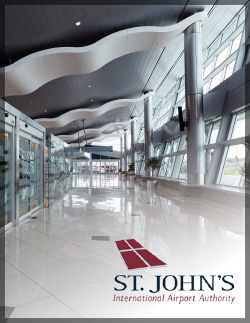The Gateway to Newfoundland
The St. John’s International Airport unveiled Phase One of a two-phase expansion project in July, 2018. Travellers can now enjoy a 40 per cent expansion in the first-floor check-in area, a departures lounge that is twice the size, three times the seating, a children’s play centre and mother’s nursing space, not to mention a brand-new concessions program featuring national and local brands like Yellow Belly Brewery, and the Newfoundland Chocolate Company, which will offer a coffee shop as well. Phase 2 of the Plan, which focuses on Arrivals, starts in 2019.
“We are really happy with how it’s come together,” says Keith Collins, President and CEO. “In terms of capacity, services, and passenger accommodation, it answers all the issues we had been dealing with in the old building.”
Gateway to the Province
The new, 145,000-square foot expansion was centred around one important principle. “This airport is the gateway to the province,” says Collins. “Over 70 per cent of non-resident visitors that travel by air to Newfoundland and Labrador travel through the St. John’s airport, and we see over 1.5 million passengers annually with 80 daily flights between 20 destinations. We acknowledge this role as our province’s major transportation gateway and govern ourselves accordingly.”
All of these changes are for naught if planes can’t land. As a contender for one of the foggiest airports in the world, and title-holder for Canada’s foggiest airport, historically, upwards of 1,000 planes annually were impacted by low visibility conditions. As part of the Expansion and Improvement Plan, St. John’s International Airport became the fourth airport in the country equipped with Category III Instrument Landing Systems (Cat 3 ILS).
An indicator of the substantial, long-term benefits of the system: In its first year of operation, 2016, a total of 291 hours (or 12 days) in which the forward visibility was ¼ mile or less (CAT 3 ILS conditions) was recorded at St. John’s International Airport. All flights operating into and out of the Airport under these low visibility conditions (approximately 960) would have been delayed, diverted or cancelled prior to the installation of the new instrument landing systems. As a result of the new systems, less than 40 flights were impacted due to low visibility conditions. The second-year results are even more impressive, with only four flights impacted by low visibility conditions.
“Greater predictability of flight operations means businesses, tourism, and conventions can operate more efficiently year-round, and means a major cost savings to the airlines and an improved level of customer service for passengers,” says Collins.
Sense of Place
Alongside the logistics of the expansion is the injection of the intangible uniqueness of St. John’s and Newfoundland and Labrador itself. And as an ambassador of sorts for both, the airport was designed to convey the culture of the province to visitors and instill a sense of pride in residents alike. There are the nods to the Maritime culture reflected in the architecture (the undulating wave-like ceiling, the lights that look like masts) and the art. Three new massive pieces of art created by Vessla Brakaolva reflect the ocean and the island’s beauty with a bright blue tapestry of sea life that adorn the entrance to the new Departure Lounge. “We wanted to find a way to differentiate ourselves from other airports,” says Collins. “We worked together with Business and Arts Newfoundland and Labrador to find artwork that is culturally relevant, iconic, and provides a strong sense of place. [Brakaolva’s] work is remarkable and rich in detail and you know instantly you are in St. John’s.”
Newfoundland hospitality
If you’ve ever flown into the St. John’s airport before, you know it’s not just an airport, but a front porch. St. John’s is one of a few remaining airports to allow people in to the baggage arrivals area to welcome friends and family. More often than not, groups of family members collect at the bottom of the stairs to greet passengers, and they outnumber travellers. “The only time we don’t accommodate this is at the peak arrival time leading up to Christmas. There can be groups of 40 greeters for each passenger, and it can become quite congested. This can create safety issues, so the area is limited to passengers at that time of year,” says Collins. “Again, it’s part of the culture.”
“We understand what the role of the airport is, and that our impact goes well beyond city limits,” continues Collins. “Understanding what our value is to our province really drives us because we understand what we do and how we do it impacts not just St. John’s, but the entire province, and it’s changed how we think about what we do here.”







 Click to view Brochure
Click to view Brochure